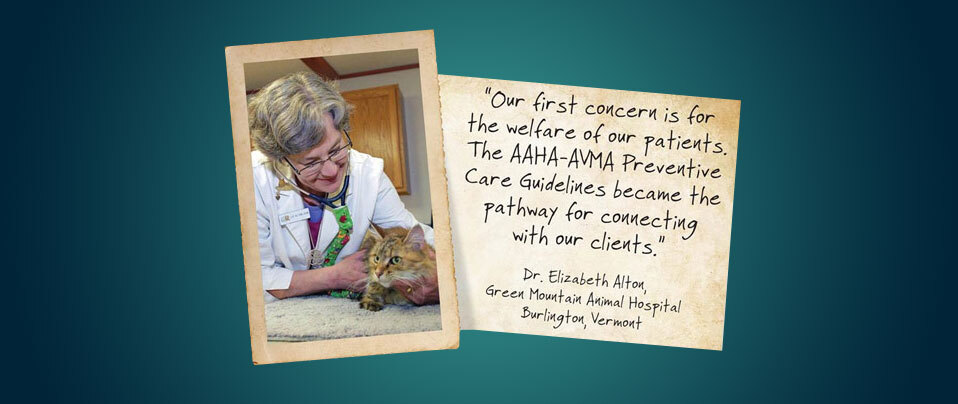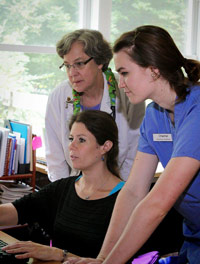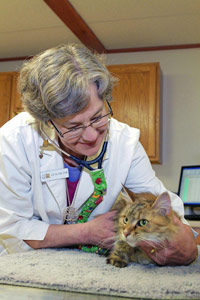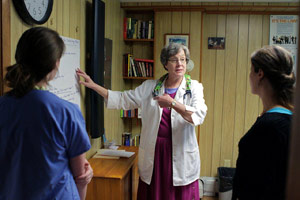AAHA-AVMA Canine and Feline Preventive Healthcare Guidelines

Online Tools Equip Staff to Use Preventive Healthcare Guidelines to Connect with Clients
After the new AAHA-AVMA Canine and Feline Preventive Healthcare Guidelines were introduced,1 Dr. Elizabeth Alton was committed to implementing them in her practice at Green Mountain Animal Hospital in South Burlington, Vermont. She was delighted that Partners for Healthy Pets provided a ready-made suite of free, professionally produced online tools for introducing the Guidelines to her healthcare team. When she began using the online resources, she quickly noticed that they had two important features.
Tips for using the Guidelines implementation tools
Dr. Elizabeth Alton at Green Mountain Animal Hospital in South Burlington, Vermont used all of the online tools produced by Partners for Healthy Pets for implementing the AAHA-AVMA Preventive Healthcare Guidelines. She offers the following tips for using these resources:
- Browse through the tools first. Several online tools are available under the Guidelines Implementation tab of the Resources Toolbox. By quickly browsing through all of them, you’ll get an idea of what they offer and won’t feel overwhelmed by trying to digest them all at once. There is also a three minute video entitled “Why do we need tools to implement the AAHA-AVMA Preventive Healthcare Guidelines?” that tells a story of how the suite of individual tools all work together.
- Use the webinar for an overview. In a one-hour presentation, the webinar tool provides the “big picture” of how the online tools work together to implement the Guidelines in your practice. Depending on the time available for staff training, the webinar can be viewed by the practice owners and managers, or by the entire healthcare team. The webinar includes a short inspirational video by Dr. Andy Roark that will remind your staff how veterinary medicine makes a positive difference in the lives of your patients and clients.
- Read the “10 Steps to Success”, “Team Meeting Guide” and “Practice Action Plan”. These handbooks provide the “how-to” detail needed to successfully train your healthcare team to implement the Preventive Healthcare Guidelines. Take time to read these materials, and jot down notes on how you’ll apply the suggestions they offer.
- Customize the PowerPoint slide presentation for your practice. Insert your own text, photos, and entire slides to make the training slides specific for your practice. For example, determine your hospital team’s unique core values and specific goals and insert them into your presentation.
- Prepare for each staff training meeting. Don’t wing it. If you do, it will show.
- Ignore the “moans and groans” about role play. Not everyone likes role play. On the other hand, some are good at it and enjoy the experience. Let those who volunteer for role play carry the ball for this exercise. In most cases, role play using the “Words that Work” scripts and videos turns out to be a positive experience.
- Assign each individual in the practice specific responsibilities for implementing the Preventive Healthcare Guidelines. Everyone should be committed, informed, and involved in implementing the Guidelines. Clients are more likely to respond to a unified practice commitment to preventive healthcare.
- Set goals. Goal-setting will help you measure how successfully your practice is implementing the Preventive Healthcare Guidelines. The Practice Action Plan provides a template for developing specific, individual goals for applying the Guidelines.
- Take the VetMedTeam.com course on “Implementing the AAHA-AVMA Preventive Healthcare Guidelines for Dogs and Cats”. The entire Green Mountain healthcare team took this excellent, free online course as an adjunct to the preventive healthcare team meetings.
- Don’t make a recommendation just once. A preventive healthcare recommendation should be repeated at every exam until compliance occurs. When this is done, clients understand that you are committed to the recommendation as a means of safeguarding the health of their pets.
“First, it was apparent that these resources weren’t like reading a practice management article in a veterinary journal,” she says. “The online tools were very specific, practical, and helpful, not general and abstract. The tools didn’t just tell us what to do, they told us how to do it, step-by-step.”
Staff Training

Dr. Alton also noticed that the online tools engaged her entire healthcare team. “It wasn’t a matter of the practice owner lecturing the staff on how we’re going to apply the Guidelines,” she continues. “The training sessions were very interactive, by design. Everyone in our practice now has a clear understanding of what the Guidelines are and how to use them. That means we’ll speak with one voice when we make preventive healthcare recommendations to our clients.
“There’s no question that these materials helped us use the new Preventive Healthcare Guidelines in a very effective way,” Dr. Alton adds. “The staff training experience strengthened and unified our practice’s commitment to making disease prevention a priority. We’re already seeing an increase in compliance in several areas of preventive healthcare. Our clients are responding to our recommendations.”
Not just a checklist
The AAHA-AVMA Preventive Healthcare Guidelines are carefully written consensus statements for a complete disease prevention program. Although the Guidelines are concise, single-page documents, they are not just a checklist. When properly implemented in clinical practice, the Guidelines make disease prevention the first objective of primary care and enlist the entire healthcare team in that mission.
To personalize the implementation of the Guidelines for an individual practice requires conducting staff training on how to effectively communicate the preventive healthcare message to clients. The Partners for Healthy Pets online tools are designed to make staff training a positive, growth experience for the practice. The tools will help motivate the healthcare team to embrace preventive healthcare as a core value, clarify individual roles in implementing the AAHA-AVMA Preventive Healthcare Guidelines, and train the staff to effectively communicate disease prevention to clients.
Healthy Life for their pets

Dr. Alton explains that the key to implementing the Guidelines is to convince clients in an authentic way that preventive healthcare is the key to a long, healthy life for their pets. “We needed to do that by demonstrating that our first concern is for the welfare of our patients,” she says. For Dr. Alton, that core value was captured by a statement in the slide presentation used for staff training: Clients need to know how much you care before they care how much you know. Dr. Alton had the ‘Clients need to know how much you care’ quotation laminated and posted in work areas throughout the hospital. “It became our motto,” she says.
“When clients get that message, they are much more inclined to comply with our recommendations. For us, it was an essential step in implementing the Guidelines. By using this approach, the Guidelines became the pathway for connecting with our clients. But first we needed to learn how to communicate our core message on a consistent, unified basis.”
The training experience
Team Meetings

In-service training of the Green Mountain staff was conducted in five team meetings conducted by Dr. Alton at biweekly intervals. The training experience was the centerpiece in how the practice implemented the Preventive Healthcare Guidelines. The principal tool for staff training was the PowerPoint slide presentation downloaded from the Partners web site and modified with photos and text to personalize it for Green Mountain Animal Hospital. The slides were designed to be interactive, not a series of lectures.
“After introducing each topic as we went through the slides, we asked questions, considered and gathered responses, and started a discussion,” Dr. Alton says. “Once we got rolling, the staff got into it and really enjoyed the experience. After the entire process was finished, I can honestly say that our healthcare team now speaks with one voice in emphasizing and explaining preventive healthcare to our clients.”
The training sessions successfully accomplished the following goals:
- Collectively define the practice’s core values, competencies, and areas for improvement as stepping stones for improving client communication.
- Review and understand the AAHA-AVMA Preventive Healthcare Guidelines.
- Discuss how the Guidelines were adapted in a protocol specific for Green Mountain Animal Hospital.
- Define individual responsibilities for implementing the Guidelines.
- Practice communicating the importance of preventive healthcare to clients.
- Set specific goals for implementing preventive healthcare in the practice.
Things that worked
One of the Partners online tools was an inspirational video (“Sharpen Your Axe”) by Dr. Andy Roark, a companion animal practitioner and motivational speaker. “We showed Andy’s video at our first team meeting,” Dr. Alton notes. “His comments on what motivated him to go into veterinary practice went over very well and got us off on the right foot. We shared our own reasons for choosing veterinary medicine as a career and how we wanted to project those feelings in our client relationships.”
In one of the team meetings, the Green Mountain staff listed what each person considered the practice’s core values to be. Each person also offered lists of three things the practice does well and could improve. As the discussion evolved, those ‘short lists’ expanded well beyond what was anticipated. The responses were used to create goals (areas for improvement) and client communication messages to explain the importance of preventive healthcare.
Dr. Alton and her staff customized the AAHA-AVMA Guidelines for their practice by adding one-line explanations for each procedure and a recommended treatment schedule. They then used their practice’s preventive healthcare guidelines as an educational tool and handout for clients. Feedback confirmed that clients found the practice’s guidelines to be very helpful and something they appreciated.
One of the goals of the team meetings was to sharpen the staff’s communication skills so that discussing preventive healthcare to clients became second nature. The “Words that Work” videos from the Partners web site were particularly helpful in demonstrating how healthcare team members can dialog with clients in a natural, positive way in various exam-room situations.
“The videos helped us communicate with the client, not at the client,” Dr. Alton explains. “They also took me out of the discussion and let the team members learn from each other how to connect with clients. The videos presented practical tips, such as asking a client how a pet got its name, to quickly create empathy with the owner.”
After observing the “Words that Work” videos, staff members discussed the communication techniques involved, then used them in actual encounters with clients. At the next team meeting, they shared their “real-world” experiences. “Through this process, we started to relate better to our clients when taking the patient’s history, during the physical exam, when making recommendations, and when responding to questions,” Dr. Alton says.
“In some cases clients challenge our healthcare recommendations. The videos helped us to respond to these situations in a positive way. We have a few clients who question everything we propose. Part of the challenge is to be able to explain preventive healthcare in a professional, non-defensive way to clients who are skeptical or think you’re trying to push services on them.”
As examples of specific preventive care recommendations, Dr. Alton cites recent outbreaks in Vermont of laboratory diagnosed canine influenza, newly emergent cases of leptospirosis, and prevalence of arthropod-borne disease. “We added vaccination for these diseases to the standard immunization protocol,” she continues. “We also recommend regular dental care and screening tests for heartworm and tick-borne diseases. Some of our clients express doubt that these procedures are needed. We explain that preventing these diseases is a whole lot easier and less expensive than treating them, and avoids pain and suffering incurred by the pet. When clients realize that our recommendations are based on concern for their pets, they’re much more inclined to accept our suggestions.”
Seeing results

All Green Mountain healthcare team members complete a self-evaluation as part of their annual performance reviews. In their comments, some staff members specifically mentioned the impact their Guidelines training experience had on how they perform their jobs. One of the practice’s technicians said, “From our preventive healthcare meetings, I feel more confident talking to clients and educating them on what I’ve learned.” Dr. Alton considers this voluntary feedback to be a strong validation of the value of the healthcare guidelines training.
Dr. Alton credits the Partners online tools for helping her practice achieve several important outcomes. “We got everyone on our healthcare team to deliver the same preventive care message to our clients and to make that a priority,” she says. “We also achieved greater client understanding of our preventive care recommendations by improving our communication skills. We adapted the AAHA-AVMA Preventive Healthcare Guidelines for our practice and routinely use them as a client education tool. Together, these initiatives have led to better compliance. Using the free, online tools, I’m convinced that any practice can apply the Preventive Healthcare Guidelines in a way that strengthens client relationships, improves compliance, and benefits the health of their patients.”
Reference
- The American Animal Hospital Association-American Veterinary Medical Association Preventive Healthcare Guidelines Task Force. Development of new canine and feline preventive healthcare guidelines designed to improve pet health. J Am Anim Hosp Assoc. 2011;47:306-311.
Tools of Interest
The following tools helped this hospital:
Read what your colleagues are saying about their experiences using specific Partners for Healthy Pets tools.
Success Stories are testimonial case studies of the benefits realized by patients and practices as a result of utilizing the Resources Toolbox!

